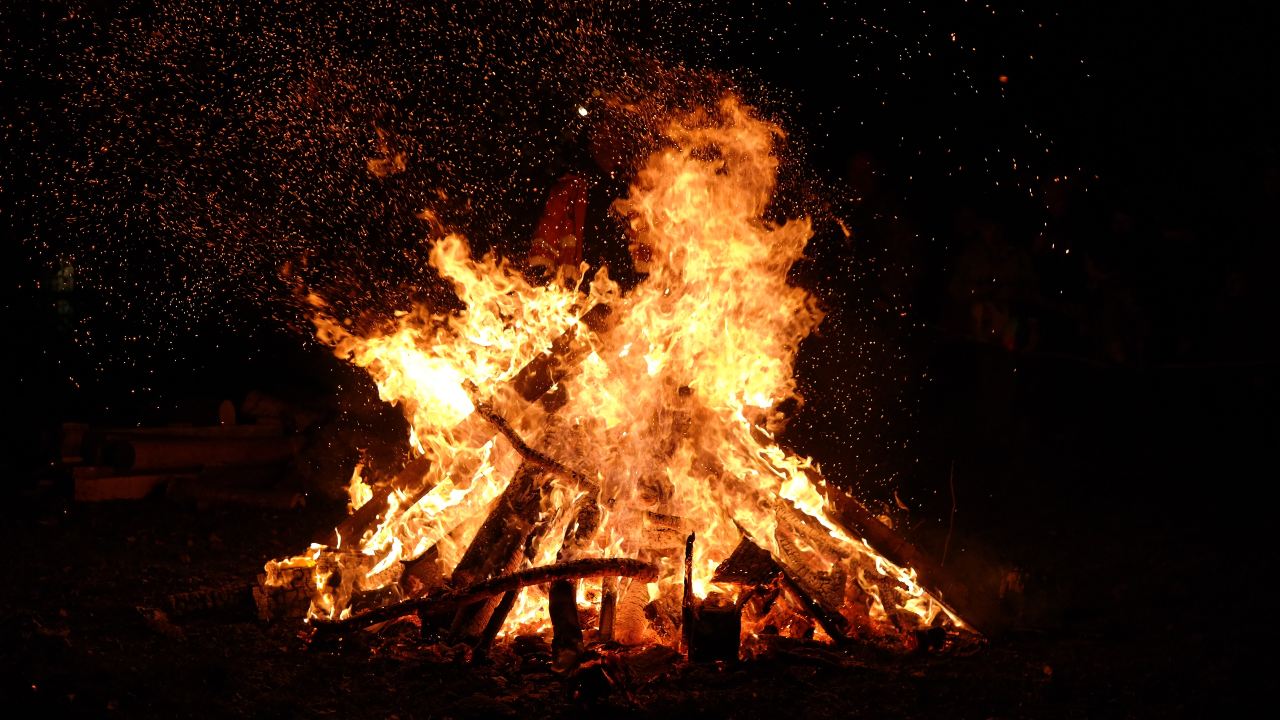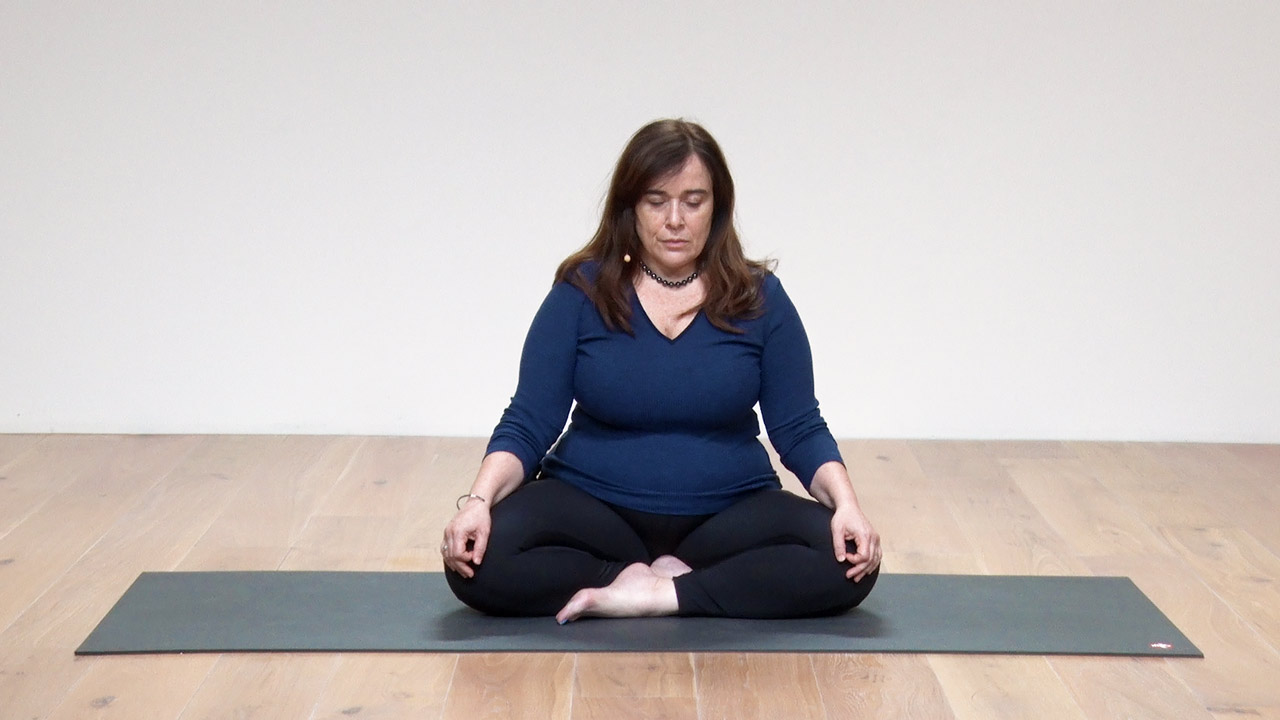Fire is an element that has been revered and explored since the tradition of yoga began over 5000 years ago – from physical fire used in rituals, to the internal flame of the heart, and the digestive fire or agni.
In the ancient Vedic texts, the fire deity (also known as Agni) is mentioned in one of the very first verses. It represents the fire within the sun, lightning, as well as the fires lit within homes and for more specialised sacrificial uses.
As the guardian of the South-East direction, the fire-god Agni was traditionally a much-invoked deity alongside Indra (god of storms) and Soma (god of the moon, and also of a special secretive drug-like liquid consumed within rituals) within the ancient and elaborate yogic sacrifices to the gods. As time passed, agni came to be associated with the action of transformation in both a physical and spiritual sense, helping transform food into energy, ideas into actions, and offerings into the smoke that drifted up towards the gods.
Fire is one of the most powerful of the elements, and when we tap into its energy, we bring alive a sense of transformation within ourselves.
Sacred Symbolism of Fire
As well as being a prevalent force within the Hindu religion and ancient yoga practices, fire is an important element featured within Christianity, Chinese culture and Judaism.
Just as the flames of fire can move and spread wildly, it seems that the symbolism of fire itself varies widely; representing divinity and purity, referring to wisdom and discernment, but also the element associated with evil and the flames of hell.
Something we can perhaps learn from this is that fire is an element both native to nature and able to be produced and harnessed by humans. We also have the responsibility of remembering how the power of fire can be used for both good and evil. If you’re a typically ‘fiery’ person, do you use that power to empower and light up others, or do you allow it to be destructive? Fire can be the catalyst for energy and dynamism, but it can also be destructive if we don’t know how to manage it.
Fire & the Manipura Chakra
The third chakra, known as Manipura (which translates at the ‘city of jewels’) or more commonly the ‘solar plexus’, is our energetic fire centre. Moving from the primal, earthiness of the root chakra, through the watery flow of the sacral chakra or Svadisthana, we reach the place that governs our inner power and digestive energy.
Manipura chakra is linked to our sense of transforming ideas into actions and food into energy, as well as our willpower and perseverance. When this place is in a balanced state, we generally feel confident in our ability to complete tasks; we feel physically and mentally powerful, and can discern ‘wrong’ from ‘right’. Underactive, and we’re likely to feel weak and unconfident, with poor digestive capacity and a lack of self-belief or inability to get things done.
If there’s too much energy moving through this chakra, we may become overly fiery, angry, irritable, pushing ourselves too hard and suffering from issues like acid reflux or heartburn. This chakra is our place of inner power, so when it comes to understanding how we use our power, it’s important to keep things balanced.
Practices to connect with the Fire Element
Touch
Heat is a catalyst for the body’s processes – it can boost circulation and ease stiffness in the joints and muscles, as well as helping to promote sweating and increasing the body’s ability to withstand high temperatures. Whilst it’s important to make sure you’re never too hot, experiencing a sauna or steam room regularly can help relieve both physical and emotional tension, sending blood flow to tissues that may need healing and repairing. Especially during colder months, try to warm your body regularly to keep circulation moving well; take a warm bath, wrap up, try a hot stone massage, or even a hot yoga class.
Taste
The fire element is linked to the sour, salty and pungent (or hot) tastes, and these are tastes that tend to make our mouths water and increase agni, the digestive fire. Consuming something sour, salty and hot before a meal can help improve both the digestion and assimilation of nutrients – I like to make an Ayurvedic mix of sliced ginger, lemon juice and a sprinkle of salt, and consume a slice just before dinner to boost digestive power.
Other foods you can use to increase the fire element within the body are, of course, hot spices like cayenne, chilli, black pepper, ginger and cinnamon, as well as vinegars. Ensure you’re eating enough good quality salty foods like seaweed and miso, and boost your intake of sour foods with chutneys, citrus fruits, kefir, sourdough bread, wine, and fermented foods like sauerkraut.
Smell
Warming, heating scents like ginger, juniper and clove can help boost the energy of Manipura chakra, but if you need to calm and balance this place, essential oils can be very helpful too. If you’re feeling overly hot physically or emotionally, try calming things down with rose, geranium, chamomile, and sandalwood essential oils. You can mix these with a cooling carrier oil like coconut oil, or a more warming and stimulating oil like mustard.
Try massaging the nabhi marma point (a pressure point linked to Manipura chakra) located at the navel centre. Massage around the navel in a clockwise direction for a few minutes, or until you feel a sense of relaxation in this place.
Sight
Tratak or ‘candle gazing’ is a traditional and meditative way to reconnect to the fire element, and is also a great way to re-set after a long day staring at laptops and screens. Tratak should be “practiced in a dark room free from draughts and insects” according to Swami Svatmarama, who compiled the Hatha Yoga Pradipika, and serves to help the mind cultivate eka grata or ‘one-pointed focus’, directing energy away from the chattering mind, and toward an object. The flame also has many representations in yogic literature, and in this sense, we can think of the flame symbolising Atman, the soul, which is often pictured as a flame within the heart.
How to practice Tratak or Candle Gazing
- Light the candle and place it at eye level, ensuring it does not flicker
- Sit in a comfortable meditative posture with the hands on the knees in Jnana or Chin mudra – your thumb and forefinger touch with your palms facing down (for Jnana Mudra) or facing up (for Chin Mudra). Set an intention or simply breathe slowly to relax the body and develop stillness
- Close the eyes, and eventually open them, gazing at the centre of the candle flame, just above the wick. Try to keep the eyes steady without blinking.
- Gaze for as long as possible without straining the eyes, and then close them when you need to
- With the eyes closed, turn the gaze up to the centre of the eyebrows. Try to keep the image of the flame in your awareness for as long as possible, focussing upon it and studying any colours that may appear
- When the image eventually disappears, repeat the process, continuing for 5-10 minutes
- If your mind wanders, focus upon the breath, imagining the breath flowing in and out of the eyebrow centre.
Sound
When was the last time you listened to the sound of a crackling fire? As humans, we’ve evolved alongside fire, and this is perhaps one of the only things we’ve continually been accompanied by for thousands and thousands of years. If you can do so safely, set up a campfire and listen to the crackling of the flames. You can also download sounds like this, and use them as part of a visualisation meditation. If you’d rather listen to a more melodic sound, the key of E is linked to Manipura chakra, so switch on a fiery, powerful song in the key of E and get yourself moving!
Pranayama
Kappalabhati breath. The ‘shining skull’ breath is a powerful way to boost the digestive fire, as well as helping stimulate the mind and body. This is an energising breath that can be used to help awaken and enliven the senses in the morning, removing sluggishness and firing the body up for the day. To practice, forcefully exhale through the nose as you feel your stomach draw in and up, then allow the inhale to be passive and occur naturally. Try doing this 10 – 20 times in a row, beginning slow and working your way up to more rapid exhales. When you need to, take a couple of slow and gentle breaths in and out, before repeating for two more rounds.
Yoga postures & movements
To fire up your Manipura chakra, work with core-focussed asanas such as Navasana (Boat pose), and arm balances that require self-confidence and power like Bakasana (crow) or Parsva Bakasana (side crow). Sun salutations, a dynamic, warming vinyasa flow practice, and active backbends like Dhanurasana (bow) and Urdvha Dhanurasana (‘upward-facing bow’ or wheel pose) can all help increase energy within the fire chakra. When you need to calm and cool off, try Balasana (child’s pose). End your practice with Savasana, and place an eye pillow over the eyes to soothe them. The eyes relate directly to the fire element, so after you’ve stoked the flames of Manipura chakra and practiced your candle gazing meditation, cover the eyes to keep things calm and balanced.
Read more of Emma’s series on The Five Elements in Yoga
- Journey through The 5 Elements: Earth
- Journey through The 5 Elements: Water
- Journey through the 5 Elements: Air
- Journey through the 5 Elements: Ether
Photo by Jens Mahnke from Pexels


